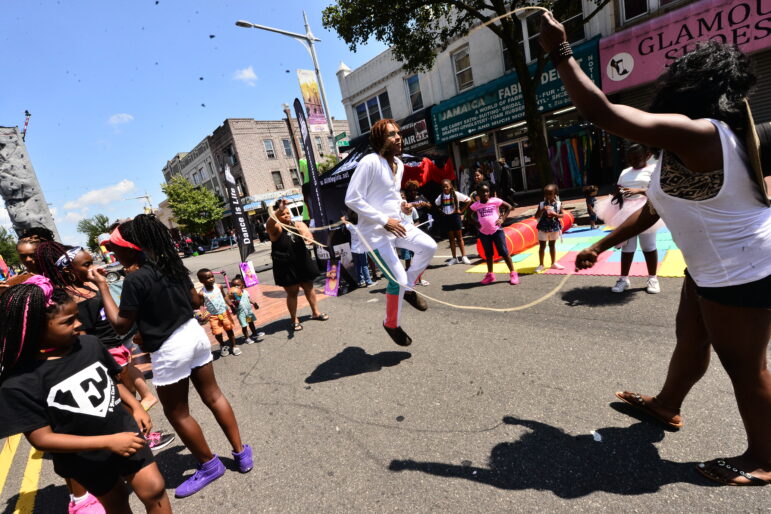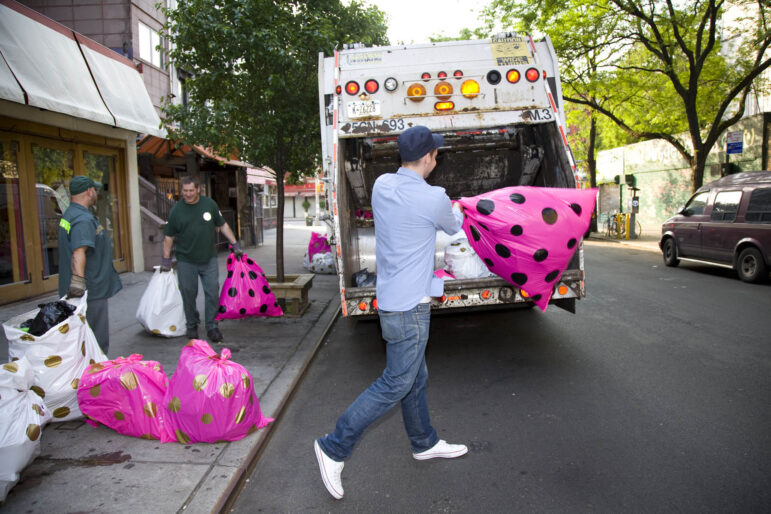“As warm weather returns and the summer approaches, we are reminded that the streets, sidewalks, parks, and plazas of New York City are our civic commons. New Yorkers should be able to dance in the streets, sidewalks, and curbs if they want to.”

Nat Valentine
A scene from the Jamaica Arts and Music Summer (JAMS) Festival in Queens.Block parties are an iconic New York City experience. They bring communities together, give kids space to run and play—they even birthed hip hop! Yet, New York City has made it so difficult to get a permit that it is now nearly impossible to plan one. You need to apply at least two months in advance with no option for a rain date, all just to close one block for half a day. This is just one of the many types of simple public space activations where bureaucratic red tape makes it unbearably challenging for community groups when they want to utilize a street or a public plaza.
As warm weather returns and the summer approaches, we are reminded that the streets, sidewalks, parks, and plazas of New York City are our civic commons. New Yorkers should be able to dance in the streets, sidewalks, and curbs if they want to. Yet for most New Yorkers, these communal spaces outside our doors remain frustratingly unavailable and inaccessible, hidden deep inside a maze of paperwork. New York City needs to reform its permitting process so that it works for, not against, community members who want to organize activities in public spaces.
Many of the permitting rules for public spaces have not been updated in decades and no longer reflect how New Yorkers want to use them today. The same time-antiquated, onerous process also applies to the liability requirements for public events. A simple meetup to play the board game Jenga requires 34th Avenue Open Street in Queens to have the same million-dollar insurance coverage as a large one-off dance performance with a stage and speakers. Even if the Jenga meetup is happening regularly, organizers must submit individual applications for each event, making planning routine events like that astoundingly time-consuming. Sometimes, Open Street organizers don’t even know if their events are approved by the city until the day before.
There are reforms that would improve this street permitting process. The city should create a single portal that provides access to all street activity permit types. There should be a permit type that covers a series of regularly scheduled events to reflect the new reality of Open Streets, and integrated activations that are popping up in neighborhoods all over the city. The city should work to develop a sliding scale of liability based on the intensity of activation.
Reforming street permits is not just a simple matter of access, but also of social equity. In neighborhoods where there are no Business Improvement Districts (BIDs), seasoned legacy organizations, or parks conservancies, the burden of applying for these permits falls on volunteer community members. These are the people who are already providing the critical work of raising funds, arranging activities, and providing maintenance services necessary for a successful event. Many communities simply do not have the time or resources necessary to also cut through the bureaucratic jungle laid in front of them.
Mayor Eric Adams campaigned on public realm improvements and his administration often champion major capital projects, like the Kimlau Plaza redesign, aimed at transforming commercial and tourism hubs, and the new people-centered amenities in the Flatiron District as part of the Broadway Vision Plan. These marquee projects have shown, on a grand scale, what’s possible for our public realm, and New Yorkers love them.
It is time to give New Yorkers, in all boroughs and all neighborhoods, more control over their public spaces. Permit reform is the next step in creating more equitable, accessible, and activated public spaces. It’s time to cut the red tape and let the block parties flourish.
Burdensome permitting policies are just one aspect of the public realm status quo that has many New Yorkers burnt out. Let’s make this year one of excitement for both the participants and stewards of our precious public realm by making it easier to make fun events happen!
Jackson Chabot is director of advocacy and organizing at Open Plans. Elana Ehrenberg is director of strategic partnerships at Design Trust for Public Space. Rebecca Macklis is senior manager of strategic initiatives at the Municipal Art Society of New York. They are members of The Alliance for Public Space Leadership, a partnership committed to improving the state of the public realm for all New Yorkers.










2 thoughts on “Opinion: Free NYC’s Block Parties from Suffocating Red Tape”
This Op Ed didn’t discuss the topic of noise impacts and decibel level limits. Does that mean that there should not be any limits and that there are no impacts? In Washington Heights and Inwood there are frequently events where the neighbors complain every time within a four or five block radius because the event organizers purposely use noise level to attract people to their event without any regard for the public health. Apparently the noise code does not address this or prevent it from happening. Event organizers in our neighborhood often abuse the privilege of a permit and blast The Neighbors without any regrets. The police standing by don’t do anything except shrug their shoulders and say the mayor approved the permit. Ostensibly the event is just for the people that are in the street on that block and the noise level should be for that purpose only since noise above certain levels cause public health impacts. I would be very interested to contribute to an article or series by city limits on this topic. There are well over a thousand members of the Facebook group, WaHi and Inwood for respectful decibel levels. Many are upset and this article could make things worse.
Hi Marjorie, thanks for reading! An interesting point — we welcome oped submissions and would certainly be open to running an opinion piece related to that, feel free to drop me an email: jeanmarie@citylimits.org